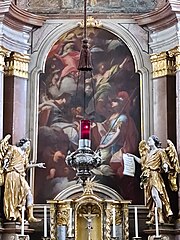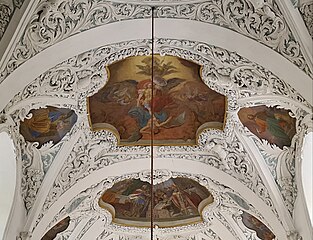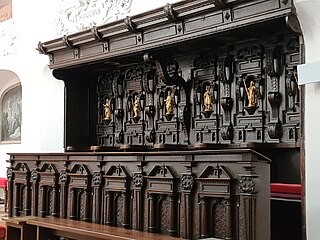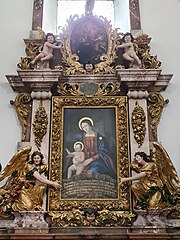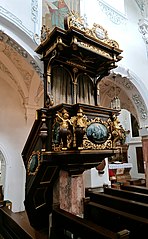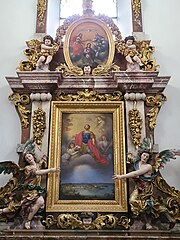Mattsee Collegiate Church
The collegiate church of St. Michael in Markt Mattsee in Salzburg is an early Gothic building from around 1276 and is listed as a listed building under the number 128484. It is the fourth church building of the Mattsee collegiate monastery , which was built on the same site as the founding church from the 8th century.
history
Based on excavation finds, it is assumed that the founding church was a pre-Carolingian wooden structure. After the battle on the Lechfeld in 955, the first stone successor was probably built. According to existing wall findings, this Ottonian hall church was replaced by a Romanesque basilica with two aisles in the 12th century . This building, which was almost the size of today's church, fell victim to a fire in 1276.
It was immediately rebuilt in the early Gothic style with a transept, side aisles and a choir with a three-eighth closure , which initially remained without a tower. In 1365 a Marienkapelle was added in the corner of the transept. After 1600 a tower was added to the west facade. The Gothic building was decorated in baroque style with stucco and frescoes around 1700 and at the beginning of the 18th century. Due to the dilapidation of the tower from the Mannerist era, today's 60 m high tower of the church, which is called "Goliath des Mattiggaues", was built in 1766 according to plans by Wolfgang Hagenauer . The former Marienkapelle was converted into a weekday chapel in 1908 through arched openings to the south aisle.
Architecture and equipment
The collegiate church presents itself as a pure basilica with a transept. The central nave appears narrow and towering and is flanked by two not even half as wide and significantly lower naves. At the transept a dreijochiger choir includes three eighth final at. To the west of the nave there is a church tower with side extensions. The upper clad windows were walled up during the Baroque era. The choir is adjoined to the south by the Antonius chapel and the weekday chapel to the two front yokes of the south aisle. The four-winged cloister is built onto the north aisle with open arches.
Choir
The marble high altar, built in 1733 based on the model of the altar in the Hellbrunn Palace Chapel near Salzburg, was decorated with sculptures by the sculptor Paul Mödlhammer . The altarpiece made by the Salzburg court painter Jakob Zanusi shows the Archangel Michael in adoration of the Most Holy Trinity.
The splendid early baroque choir stalls were created in 1650 by the carpenter Mattäus Steinle , who furnished it with statuettes of the twelve apostles, the originals of which are in the Mattsee Abbey Museum.
The decoration of the choir completes the vault decoration, next to the high altar the most conspicuous decoration of the church. The ceiling and wall pictures created by Josef Rattensperger in 1851/52 frame the rich stucco decoration from around 1700. The main frescoes show the foundation of Mattsee Abbey by Tassilo III. (above the high altar), Michaels fight against the fallen angels and The Last Supper .
Central nave and transept
The most important works of art in the transept are the side altars equipped with sculptures by Meinrad Guggenbichler . The northern one was donated by the Maria Trost Brotherhood and shows the corresponding themed picture in the main picture, which is accompanied by two framed angels and Saints Peter and Paul. The southern one was dedicated to St. Dedicated to the martyr Cölestin. The main picture shows the saint as patron of the place and the Mattsee Abbey. This is in turn accompanied by two frame-bearing angels and here by Saints Stephen and Laurentius.
The figural decoration of the pulpit, probably made by Ferdinand Oxner at the beginning of the 18th century, shows the symbols of the evangelists . On the ascent and on the basket there are also oval paintings, the main picture on the front depicts The Dispatch of the Apostles .
The ceiling frescoes, mostly painted by Josef Rattensperger, show the Annunciation (left), the bronze serpent (right) and the Assumption of Mary (crossing) in the transept , as well as the adoration of the magicians , the Holy Spirit , Christ is nailed to the cross and Jesus is deposed in the central nave . On the nave walls and in the choir there are large-format paintings showing the twelve apostles. These were also created by Josef Rattensperger.
The gallery parapet is decorated with angel motif oval paintings in grisaille technique in gilded stucco frames. Other noteworthy sculptures can be found in the transept arms of the plague altar, which was removed in 1852, depicting Saints Sebastian and Rochus (both 1685, attributed to Michael Zürn the Younger).
Aisles and chapels
Like the central nave, the choir and the transept, the side aisles and the attached chapels are also richly stuccoed. On a wide column in the north aisle there is a late Gothic fresco of St. Christopher . An expressive and historically significant crucifixion group from the 18th century hangs on the west wall of the south aisle; the sources give no information about the artist. In the Antonius Chapel there is a neo-baroque altar with the relief image of the vision of St. Anthony , in front of it there is a late Gothic baptismal font. The former baroque triumphal arch cross from the former parish and current cemetery church of St. Laurentius is installed in the weekday chapel.
organ
The organ was built in 1971/72 by Dreher & Reinisch . The historical prospectus comes from an organ by Johann Christoph Egedacher from 1710. The instrument has 18 stops on two manuals and a pedal and was completely renovated in 2006. Two registers of the Egedacher organ are still preserved.
Cloister
In the cloister there are eight gravestones and epitaphs, mostly from the Mattsee monastery deans, mainly from the late Gothic period. Also worth mentioning are those of Engiscalus , one of the first monastery deans , and of Diemut , wife of a nobleman from 1384.
literature
- Roland Peter Kerschbaum: Stiftspfarrkirche St. Michael in Mattsee . Publishing house St. Peter, Salzburg 2010.
- Brigitte Heinzl: Johann Meinrad Guggenbichler . Art publisher Peda, Passau 1999.
Web links
Individual evidence
- ^ Roland Peter Kerschbaum: Stiftspfarrkirche St. Michael in Mattsee . Verlag St. Peter, Salzburg 2010, page 9.
- ^ Roland Peter Kerschbaum: Stiftspfarrkirche St. Michael in Mattsee . Verlag St. Peter, Salzburg 2010, page 11.
- ↑ Information about the organ on orgbase.nl. Retrieved July 26, 2020 .
Coordinates: 47 ° 58 ′ 15 ″ N , 13 ° 6 ′ 18 ″ E




